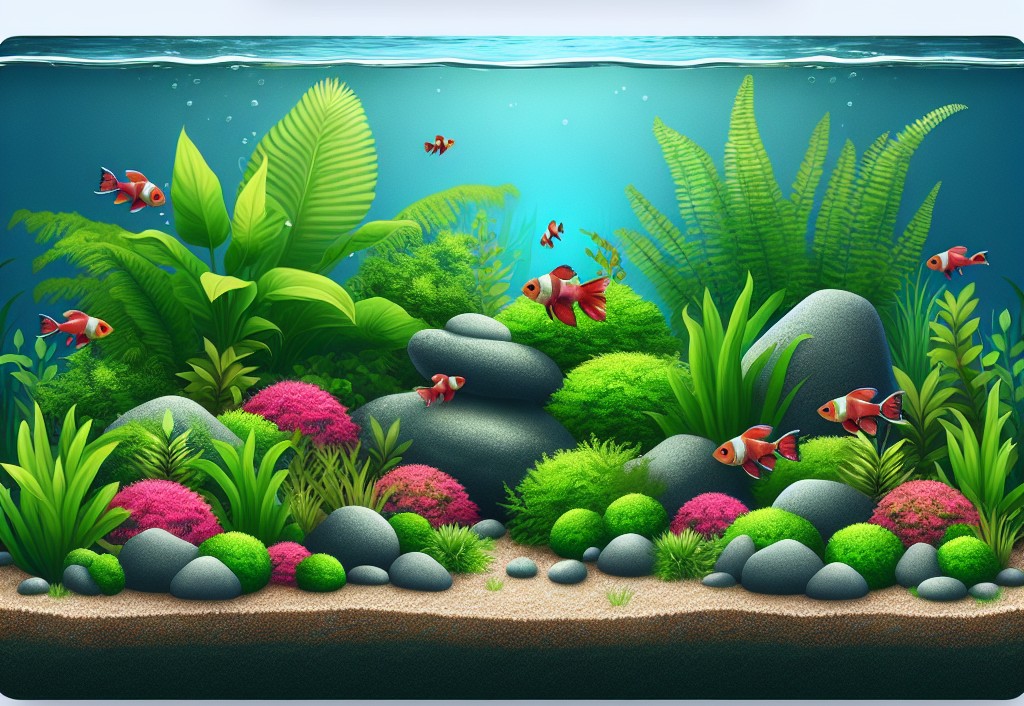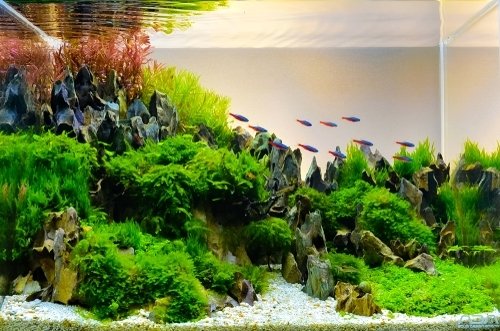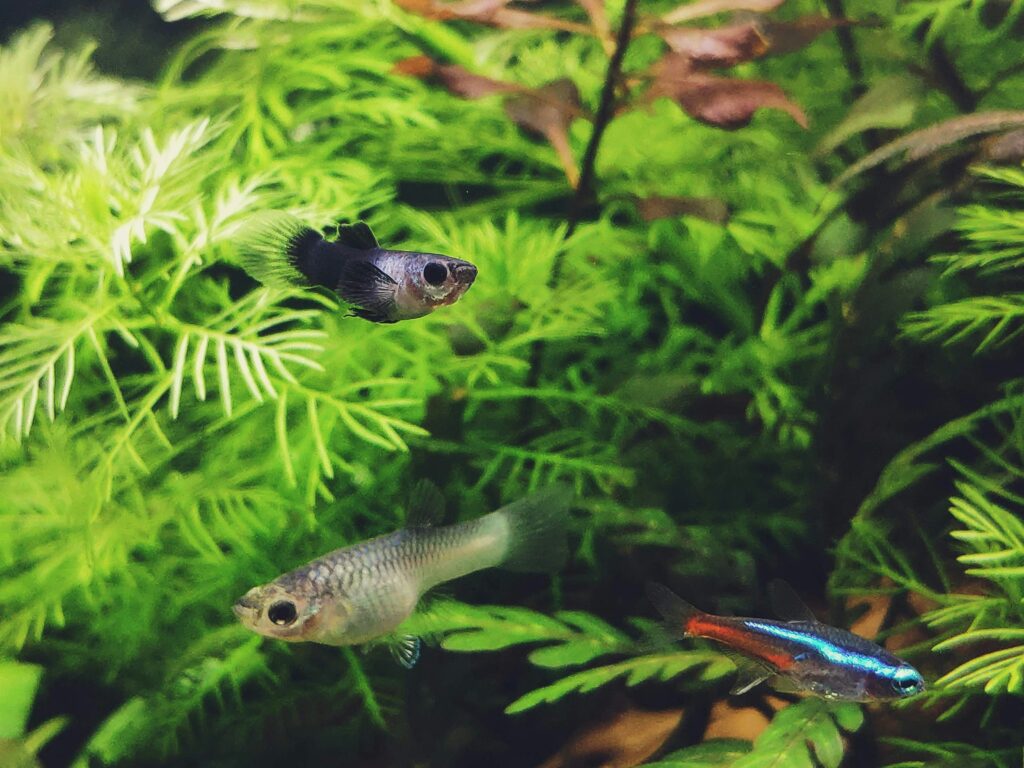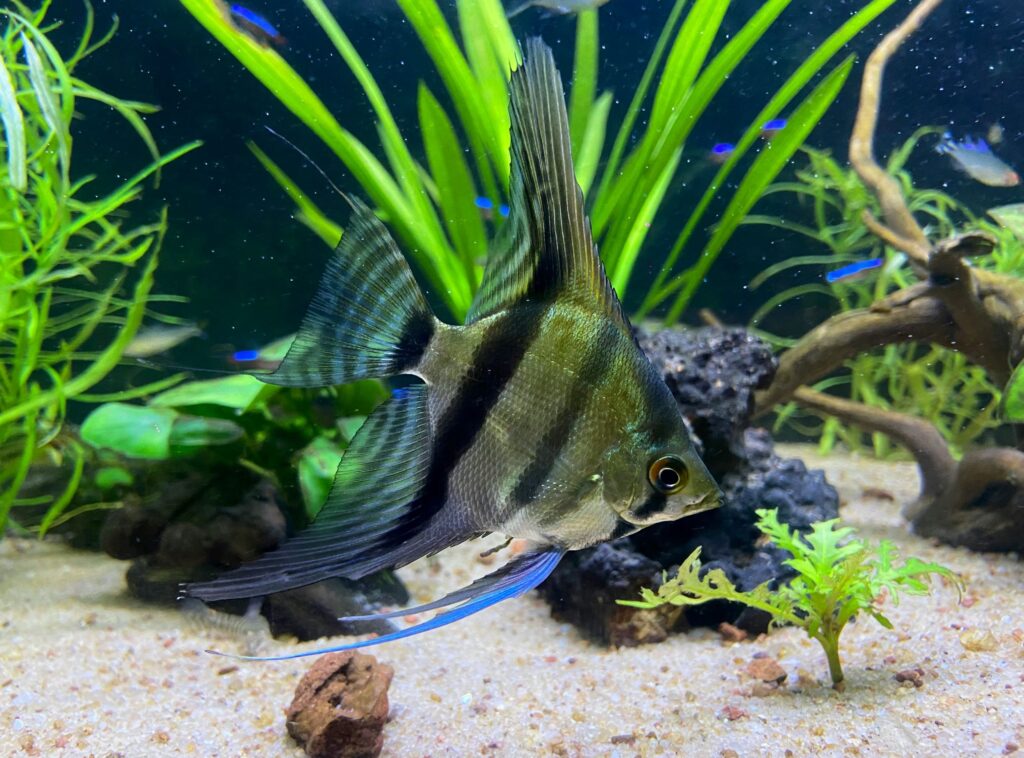Aquascaping is like creating an underwater garden in your fish tank. It’s about arranging plants, rocks, and wood in a way that looks beautiful and natural.

New to Aquascaping – What is Aquascaping?
Imagine designing a mini landscape underwater, using aquatic plants, stones, and driftwood. That’s aquascaping! It’s not just about keeping fish; it’s about crafting a scene that brings a piece of nature into your home.
Basic Aquascaping Principles
To start aquascaping, keep these ideas in mind:
- Simplicity: Don’t overcrowd your tank. Using fewer types of plants and decorations can make your design look cleaner and more appealing.
- Variety: While keeping it simple, add different elements to avoid a boring look. Mix various plants and materials to create interest.
- Proportion: Balance is key. Make sure there’s an even mix of open space and filled areas. Using plants of different sizes helps give depth to your design.
- Persistence: It might take a few tries to get your aquascape just right. Don’t be afraid to rearrange things until you’re happy with the result.

Aquascaping Equipment and Materials
Here’s what you’ll need:
- Lighting: Good lighting helps your plants grow healthy and strong. It’s like the sun for your underwater garden.
- Water Filters: These keep the water clean by removing waste and chemicals, ensuring a healthy environment for your fish and plants.
- Carbon Dioxide (CO₂): Plants need CO₂ to grow. Adding a CO₂ system can boost plant health, but it’s an extra step that some setups might not require.
- Liquid Fertilizers: Think of these as vitamins for your plants, providing essential nutrients they might not get otherwise.
Popular Aquascaping Styles
There are different styles you can try:
- Nature Aquarium: This style aims to mimic natural landscapes like forests or mountains underwater, creating a serene and organic look.
- Iwagumi: A Japanese style that focuses on arranging rocks in a simple yet striking way, often with minimal plant varieties.
- Dutch Aquarium: Known for its vibrant plant arrangements, this style resembles a colorful underwater garden with various plant species organized in terraces.

New to Aquascaping – Tips for Beginners
- Learn About Plants and Fish: Understand which plants and fish work well together and their specific needs.
- Understand Water Chemistry: Knowing about water parameters like pH and hardness helps maintain a stable environment.
- Start Simple: Begin with easy-to-care-for plants and gradually experiment as you gain confidence.
Aquascaping is a fun and rewarding hobby that lets you express creativity while building a healthy habitat for aquatic life. With patience and practice, you can design a stunning underwater world right in your own home.
Choosing Your First Plants
When you’re just starting out, picking plants can feel tricky. It’s best to begin with easy-to-grow plants. Some good beginner choices include Java moss, Java fern, and Anubias. These plants don’t need much special care or strong lighting, making them perfect for beginners.
Picking Fish for Your Aquascape
Fish can make your aquascape even better, but it’s important to pick the right kind. Smaller fish usually fit better, as they don’t disturb plants or decorations. Good beginner fish are neon tetras, guppies, and shrimp. Always research each fish to make sure it will be happy in your tank.
Setting Up Your First Aquascape
Here’s a simple guide to get you started:
- Clean Your Tank:
Rinse your tank and all decorations carefully to remove dirt or chemicals. - Add Substrate:
Put special gravel or soil in the bottom of your tank. This helps your plants grow strong roots. - Arrange Rocks and Driftwood:
Place rocks and wood to create the basic shape of your landscape. Remember to leave space for plants! - Plant Your Plants:
Carefully place your plants in the soil or tie them gently to rocks or wood. Don’t rush this part—take your time to make it look good. - Fill Your Tank Slowly:
Pour water into your tank slowly so you don’t disturb your arrangement. Pouring water over a plate or plastic bag can help protect your plants and decorations. - Set Up Equipment:
Connect your water filter, heater (if needed), and lighting. - Let It Cycle:
Before adding fish, your tank needs to run for several weeks. This helps healthy bacteria grow, making the tank safe for fish.

Caring for Your Aquascape
- Regular Water Changes:
Change about 10-20% of the water every week. This keeps your tank clean and healthy. - Trimming Plants:
Cut plants back when they grow too big or messy. This helps them grow fuller and healthier. - Watch for Problems:
Check regularly for algae or sick fish. Fixing small problems early makes them easier to solve.
Common Mistakes and How to Avoid Them
Here are some common mistakes beginners make—and how to avoid them:
- Overfeeding Fish:
Only feed your fish as much as they can eat in a few minutes. Extra food pollutes the water. - Crowding Your Tank:
Don’t add too many fish or plants. A crowded tank can lead to stress, disease, and unhealthy plants. - Ignoring Maintenance:
Regular cleaning and water changes keep your aquascape looking great. Skipping maintenance can quickly lead to problems like algae growth and unhealthy fish.
New to Aquascaping – Wrap Up
Have Fun and Be Creative!
Aquascaping is all about creativity and enjoying the beauty of nature. Don’t be afraid to experiment with different arrangements and learn from mistakes. With practice and patience, you’ll create an amazing underwater garden you can proudly show off!